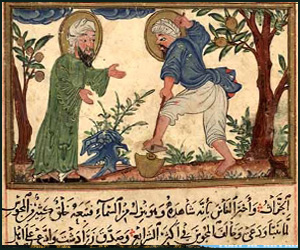|
Farming /Husbandry Manuals
Back to the Yemeni
contribution to observe
how the
famed Calendar of Cordova, which regulates farming activity
throughout the year is once more based on Eastern origins, The
Yemen
having a calendar in use
for agricultural and activities as reported by al-Hamdani, about
900.[1]
With regard to Muslim farming manuals, it is generally accepted
that, with
rare exceptions, they seem to have been mostly translated in the
19th century into Western languages to have any
impact on the revival of Western farming.
Included amongst these late translations is a
treatise on horses, horse riding, and
veterinary matters by Abu Yusuf Kitab al-furusiyeh, and a
veterinary treatise by Abu Bakr, which were translated into
French by Perron.[2]
There are, however, medieval translations of Muslim works, which
relate to farming and animal husbandry, or zoology.
These include De
animalibus of Ibn Sina
by Michael Scot, which,
in the 13th century,
introduced in the West important zoological texts.[3]The
Majmu fi’l Filaha (Compendium of farming), attributed to
Ibn Wafid (Abenguefith) but in fact a work by Al-Zahrawi
,
had two translations of it in romance languages, Catalan[4]and
Castilian.[5]This
work had great influence on the `Renaissance
’
work of agronomy, the Agricultura General of Gabiel
Alonso Herrera (d. c. 1539).
The 11th century farming treatise by Ibn
Bassal of Toledo
,
which in its abridged form was published at Tetuan in 1955, was
translated into Castilian in the Middle Ages.[6]
There
are a number of issues raised when looking at the translation of
a particular treatise: Kitab
al Filaha (Book of Agriculture
)
of Ibn al-Awwam (fl. End 12th century). It was
translated into Spanish
early in the 19th
century by Don Josef Antoine
Banqueri.[7]
A French translation in the second half of the 19th
followed,[8]as
the treatise was
of particular interest in Algeria (as it was in Spain).[9]This
treatise by Ibn al-Awwam has 34 chapters covering 585 plants,
explaining the cultivation of more than 50 fruit trees, making
observations on grafting, soil properties, manure, plant
diseases and their treatments, irrigation, affinities between
trees, animal husbandry and bee keeping.[10]
It seems it had no earlier
impact than the 19th century. And yet,
Lopez asks what, for instance, will a comparative study of
farming manuals of Ibn al-Awwam and Pietro de Crescenzi give.[11]Pietro
dei Crescenzi, born in Bologna (1230-33 died in 1320) is an
Italian writer on husbandry. Although citing Ibn Sina
,
Al-Razi
;
Ishaq al-Israili, Ibn Sarabi,[12]he
still makes no mention of Ibn al-Awwam. The two works are
extremely similar, though. This, hence, raises matters similar
to those raised in preceding chapters on whether Islamic works,
even if apparently not translated, were still copied in `an
unofficial’ manner. Sarton
points out that
translation was not absolutely necessary, for there remained in
Spain until the beginning of the Renaissance
a goodly number of
people who could read Arabic.[13]
Furthermore, it has been shown that Fray Gabriel Alonso Herrera,
who wrote Agricultura general, has in his text many
correspondences of Ibn al-Awwam, and he actually studied in
Grenada and often alludes to the Grenadan Moors.[14]
Knowledge included in Islamic farming manuals often found itself
transferred straight onto the ground, or other practical
manifestations. In Sicily
,
Bresc notes, can be found many techniques described or suggested
in the contracts of the 14th and 15th
century also found in Muslim farming manuals.[15]
Many ploughing methods to prepare the soil, the use of
fertilisers, planting, etc, are also shared by both Islamic
farming manuals and practice on the island.[16]
Equally the plants grown in Sicily are well elaborated upon in
Muslim farming manuals, a rich variety which, most importantly,
contrasts with the absolute dearth of crops of northern European
gardens.[17]
Note
must be made, here, of the work by Attie[18]on
Islamic manuscripts at the Bibliotheque Nationale de Paris as an
extremely useful source for primary and secondary sources to
enlighten on some of the issues presented here.[19]
[1]
R. B. Serjeant: Agriculture
and
Horticulture; op cit; p. 538.
[2]
Le Naceri: Traite complet
d'hippologie et d'hippiatrie,
Paris, 1852-1860, 3 vol.
[3]
J. L. Gaulin: Giordano Ruffo et l'art veterinaire: in
Micrologus; op cit; pp 185-198: p.187.
[4]
The medieval Catalan version can be found in the
Bibliotheque Nationale of Paris; Number 93 by A. Morel
Fatio, Catalogue des manuscrits espagnols et des
manuscrits Portugais, Paris, 1982; pp. 332-3.
[5]
Text in Castilian edited by J.M.
Millas Vallicrosa: La traduccion castellana del Tratado
de Agricultura’ de Ibn Wafid; Al-Andalus; 8;
1943; pp. 281-332.
[6]
R. B. Serjeant: Agriculture
and
Horticulture; op cit; p. 540.
[7]
Libro de
agricultura, ed. J. A. Banqueri (Madrid, 1802).
[8]
Ibn
Al-Awwam: Le Livre de l'Agriculture
d'Ibn al-Awwam,
tr. from Arabic by J.J. Clement-Mullet, Vol.
I, Paris 1864.
[9]
J. Vernet and J. Samso: Development of Arabic Science in
Andalusia
, in
Encyclopaedia
(Rashed ed) pp 243-76; at
p 263.
[10]
Carra de Vaux
: Les Penseurs... op cit, pp. 300-6.
[11]
R Lopez:
Les Influences Orientales; op cit; p. 621.
[12]
G. Sarton
: Introduction; op cit; Volume III; p.813.
[13]
G. Sarton
: The Appreciation; op cit; p.131.
[14]
R. B. Serjeant: Agriculture
and
Horticulture: op cit; p. 541.
[15]
H. Bresc: Les Jardins de Palerme; op cit; p. 69.
[16]
Ibid.
[17]
Ibid. p. 71.
[18]
B. Attie: Les Manuscripts agricoles Arabes de la
Bibliotheque Nationale de Paris; Hesperis Tamuda;
Vol 10; 1969; pp. 241-61.
[19]
See: Casiri: Bibliotheca arabico-hispana; Madrid;
1760. |
